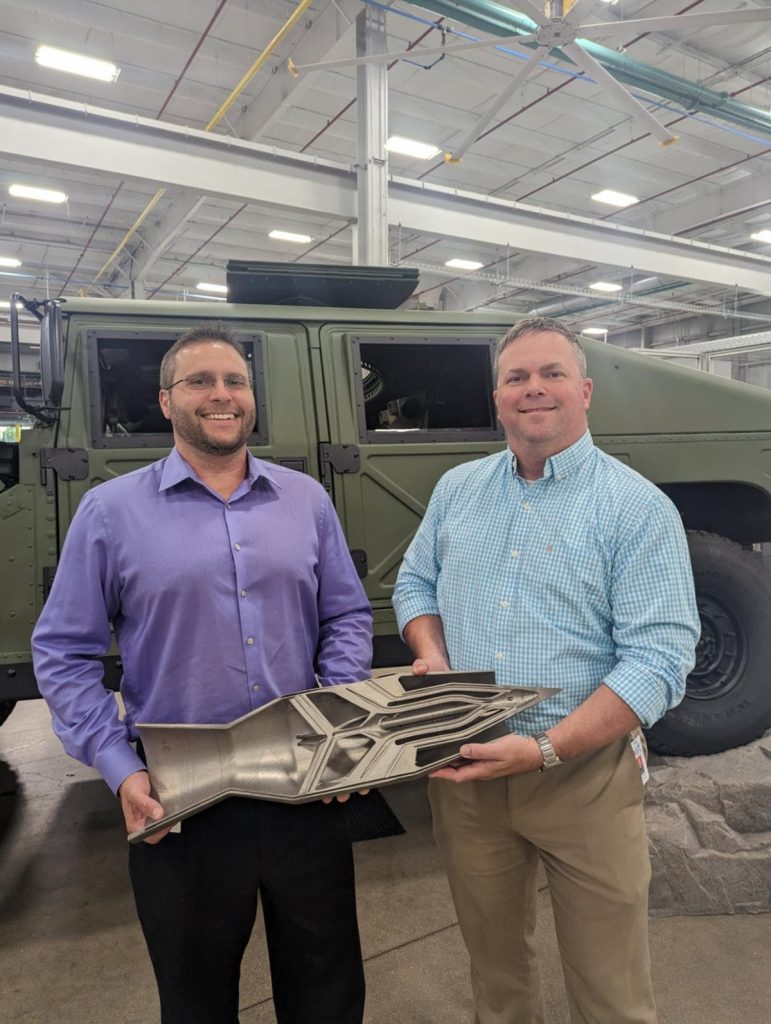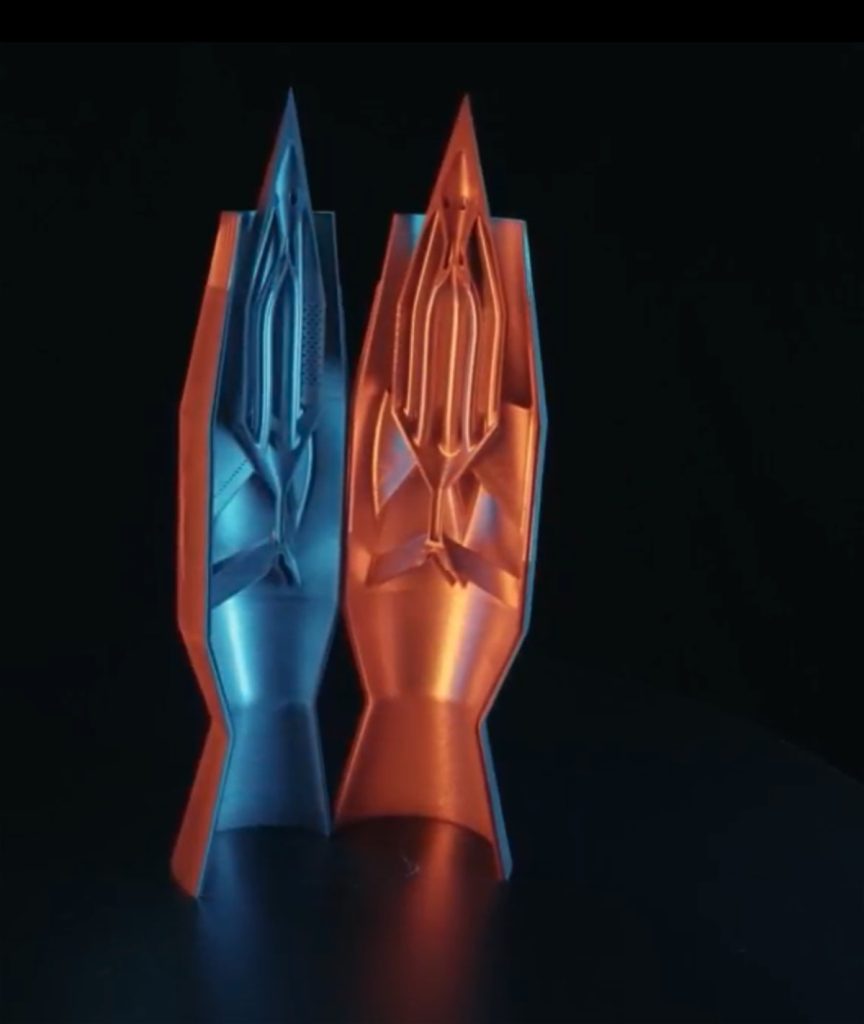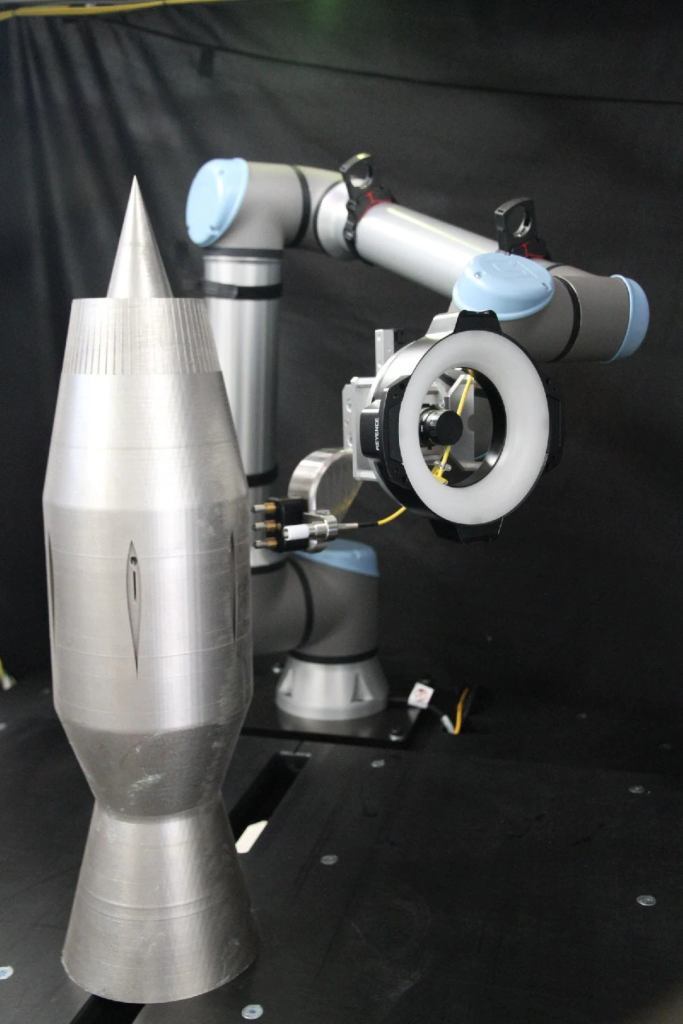Nominate now for the 3D Printing Industry Awards 2023.
Aerospace and defense contractor Lockheed Martin, metal 3D printer manufacturer Velo3D and aerospace part inspection company Vibrant have collaborated with the US Department of Defense’s (DoD) LIFT Institute to assess the validity of 3D printing hypersonic ramjet engines.
The team manufactured and tested the components to determine whether additive manufacturing techniques can be used to efficiently and reliably produce certified mission-ready ramjet engines.
These sophisticated engines, unlike their turbojet counterparts, possess very few moving parts and an extremely complex interior structure. High pressure is produced by “ramming” external air into the combustor using the forward speed of the aircraft. Compression occurs through a series of shock waves which, in conjunction with the internal geometry, compress and decelerate the air until it becomes subsonic in the combustion section.
Once 3D printed using Velo3D’s laser powder bed fusion (LPBF) technology, the ramjet’s were subjected to Vibrant’s acoustics-based Process-Compensated Resonance Testing (PCRT). This testing process analyzed a number of key physical properties, including stress state, part integrity, geometry, and surface finish.
Ultimately, this project has been viewed as a success, with the team’s attention now turning to the next research stage. This next stage will consider the fatigue behavior of 3D printed components, and move towards “born-certified” parts.
“When it all backed out, it was a very successful program,” commented Dr. John Keogh, LIFT’s Engineering Director. “I was thoroughly impressed by the whole body of work. The team of Velo, Lockheed Martin and Vibrant formed a powerful group of partners who are probably some of the closest—if not the closest—to solving this problem of qualification and validation or certification of AM components for mission-critical and safety-critical applications.”
Looking to the future, Keogh added “We want to see hypersonic components born right out of the machine that are already certified by way of the data stream we’ve captured to back it up.”

A move towards 3D printed hypersonic engines
In recent years, the defense and aerospace industries have experienced a growing urge to advance the development of propulsion systems that can achieve supersonic (above Mach 1, the speed of sound) and hypersonic (above Mach 5) flight speeds.
3D printing is being increasingly acknowledged as a technology that can manufacture these complex, single-piece engine designs at lighter weights and in less time than conventional manufacturing.
Back in 2022, US aerospace start-up Hermeus successfully tested its partially-3D printed hypersonic Chimera engine. During testing, the Chimera proved capable of transitioning from turbojet mode into a high-Mach speed ramjet model. Elsewhere, Aerojet Rocketdyne has also conducted flight testing of its 3D printed scramjet engine, as part of a US hypersonic missile research project.
Now, through the LIFT institute, the DoD is investing resources into assessing whether these additively manufactured engines can reliably operate under the extreme environmental conditions produced during hypersonic flight.
One of more-than-50 active projects under contract from the LIFT Institute, the ramjet project is also participating in the ongoing “Hypersonic Challenge.” This initiative is funded by the DoD’s Manufacturing Technology Program, and is being overseen by the Office of the Under Secretary of Defense for Research and Engineering.
The ultimate goal of this challenge is to identify which materials and/or manufacturing processes can provide the most productive and efficient pathways to vehicles and missiles capable of hypersonic flight.
LPBF 3D printed hypersonic ramjet engines
Through the ramjet project, the team sought to identify what data streams they could collect during the LPBF 3D printing process, and then conducted a well-established Design of Experiments to interrogate those data streams. Lockheed Martin established the quality assurance verification approach used in the project.
The ramjet engine was 3D printed using Velo3D’s Sapphire 1 MZ LPBF 3D printer, in conjunction with Inconel 718 metal alloy. The Sapphire 1 MZ can 3D print objects up to one meter in height, with the final ramjet piece measuring 751 mm tall. Moreover, the Sapphire system also contains hundreds of sensors that monitor, report and save metrics throughout the build process. “Velo3D’s machine collects an immense amount of data,” explained Keogh. “It also provides a very generous build envelope oriented towards volume manufacturing.”
Thanks to Velo3D’s Intelligent Fusion and the Sapphire’s patented recoater technology, no support material was needed when 3D printing the ramjet model. During the 3D printing process, once each layer of powder is laid down, the blade that normalizes it is followed by a vacuum that picks up excess powder and leaves behind a perfect powder layer. This creates a free space between the blade and the part, removing the risk of a collision as the part grows, and eliminating the need for supports.
Whilst initially designed to be incorporated into a supersonic jet engine, the team claims that a few small tweaks could easily transform their ramjet engine into a scramjet (supersonic combustion ramjet). Effectively, a scramjet is a ramjet with an adjusted inlet and outlet nozzle that keeps higher airflow speeds through the engine. Theoretically, scramjet-powered vehicles can reach hypersonic velocities exceeding Mach 5.
In addition to the ramjet engines, the team also 3D printed a number of material test parts. Named for their unique shapes, the “dog bone” parts were used for tensile pull testing, and the “detergent pacs” were produced for density and surface finish evaluation.

Acoustics-based testing
The 3D printed ramjets and test pieces were then assessed using Vibrant’s PCRT process. During testing, PCRT used ultrasonic frequencies between 5 and 500 kHz to excite the vibrational modes of the part for a few seconds or minutes at a time. The natural resonance frequencies of the part, unique to both its geometry and material properties, were recorded, saved and analyzed.
Through this process, the team could identify resonance fingerprints which reflect the stress state, part integrity, geometry, and surface finish of the component. According to Vibrant, the PCRT can also potentially be correlated to energy density and scanning speed settings, raw material properties and sourcing, build position, cooling rates, and post-processing methods like hot-isostatic-pressing and residual stress. Essentially, it is claimed that any process parameter affecting material state and mechanical properties can be assessed by PCRT.

As each part’s resonance values are captured at different frequencies and compared against the others, the metrics of high-quality parts coalesce around the same values. As such, outliers stand out and can be easily identified. Therefore, confidence-limit boundaries can be determined, whilst feedback is provided that promotes manufacturing consistency and ensures final product quality from batch to batch.
“This is a very attractive approach to couple with and complement additive manufacturing because it’s volumetric, rapid, and it doesn’t require destructive testing,” commented Keogh. “It can provide indications of porosity, surface defects, aberration in the geometry and so forth.”
Subscribe to the 3D Printing Industry newsletter to keep up to date with the latest 3D printing news. You can also follow us on Twitter, like our Facebook page, and subscribe to the 3D Printing Industry Youtube channel to access more exclusive content.
Are you interested in working in the additive manufacturing industry? Visit 3D Printing Jobs to view a selection of available roles and kickstart your career.
Featured image shows John Keogh (left), technical lead, and project manager Brad Friend holding a cut section of the 3D printed ramjet. Photo via LIFT.

